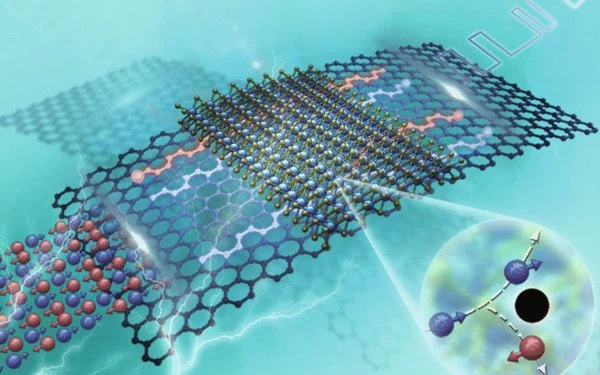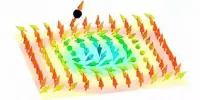Chiral phonons are a type of phonon that has a net angular momentum and a handedness, or chirality, similar to how our hands are mirror images of each other. These phonons can be created in materials that have structural asymmetry or are non-centrosymmetric.
North Carolina State University and the University of North Carolina at Chapel Hill researchers used chiral phonons to convert waste heat into spin information without the use of magnetic materials. The discovery could pave the way for new classes of low-cost, energy-efficient spintronic devices to be used in applications ranging from computational memory to power grids.
Spintronic devices are electronic devices that use an electron’s spin rather than its charge to generate current for data storage, communication, and computation. Spin caloritronic devices, so-called because they generate spin current using thermal energy, are promising because they can convert waste heat into spin-information, making them extremely energy efficient. Current spin caloritronic devices, on the other hand, require magnetic materials to generate and control the electron’s spin.
“We used chiral phonons to create a spin current at room temperature without needing magnetic materials,” says Dali Sun, associate professor of physics and member of the Organic and Carbon Electronics Lab (ORaCEL) at North Carolina State University.
We used chiral phonons to create a spin current at room temperature without needing magnetic materials. You can direct the angular momentum of chiral phonons and create and control spin current by applying a thermal gradient to a material containing chiral phonons.
Dali Sun
“You can direct the angular momentum of chiral phonons and create and control spin current by applying a thermal gradient to a material containing chiral phonons.” Jun Liu, an associate professor of mechanical and aerospace engineering at NC State and a member of ORaCEL, agrees.
The study, published in Nature Materials, is co-authored by Liu and Sun.
Chiral phonons are atomic groups that move in a circular pattern when excited by an energy source, in this case heat. The circular motion, or angular momentum, of phonons is propagated through a material as they move through it. The source of spin is angular momentum, and the direction of spin is determined by chirality.
“Chiral materials are materials that cannot be superimposed on their mirror image,” Sun says. “Think of your right and left hands – they are chiral. You can’t put a left-handed glove on a right hand, or vice versa. This ‘handedness’ is what allows us to control the spin direction, which is important if you want to use these devices for memory storage.”

Using a thermal gradient to introduce heat into the system, the researchers demonstrated chiral phonon-generated spin currents in a two-dimensional layered hybrid organic-inorganic perovskite.
“A gradient is required because the material’s temperature difference – from hot to cold – drives the motion of the chiral phonons through it,” Liu explains. “The thermal gradient also enables us to generate spin current from captured waste heat.”
The researchers hope that their work will result in spintronic devices that are less expensive to manufacture and can be used in a wider range of applications.
“Eliminating the need for magnetism in these devices means you’re opening the door wide in terms of access to potential materials,” Liu says. “And that also means increased cost-effectiveness.”
“Using waste heat rather than electric signals to generate spin current makes the system energy efficient — and the devices can operate at room temperature,” Sun says. “This could lead to a much wider variety of spintronic devices than we currently have available.”
This discovery has important implications for the development of spintronic devices that do not require the use of magnetic materials, which can be expensive and difficult to work with. It also opens up new possibilities for the study of spin-phonon interactions and the manipulation of spin currents using phonons.
















